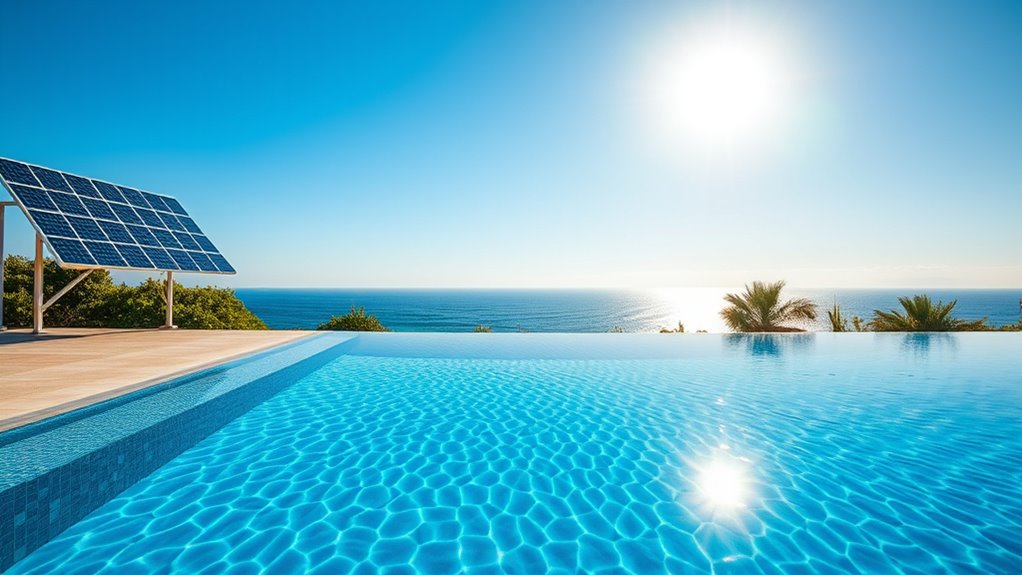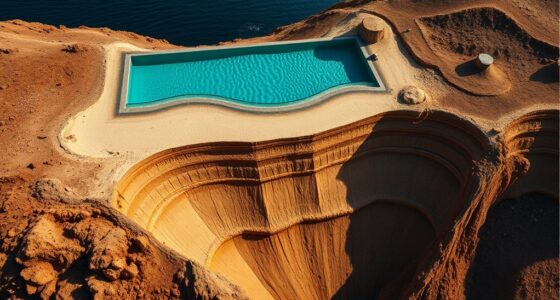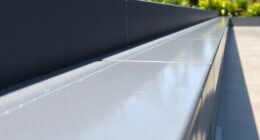Infinity pools can spike your energy bill due to continuous water circulation, heating, and filtration. To cut costs, use energy-efficient pumps, install covers to prevent heat loss, and schedule equipment during off-peak hours. Regular maintenance and smart tech can also help you monitor and reduce usage. Incorporating solar or renewable energy options offers more savings. Keep exploring to discover simple ways to make your infinity pool more budget-friendly and energy-smart.
Key Takeaways
- Regularly maintain filters and equipment to ensure efficient operation and reduce unnecessary energy consumption.
- Use pool covers to minimize heat loss, evaporation, and lower heating and filtration energy needs.
- Install energy-efficient pumps, heaters, and LED lighting, and schedule operation during off-peak hours to cut costs.
- Incorporate solar panels or other renewable energy sources to offset high energy demands sustainably.
- Utilize smart controllers and timers for precise management of pump and heater operation, preventing waste.
Understanding the Energy Demands of Infinity Pools

Infinity pools require a significant amount of energy to operate, primarily due to the need for continuous water circulation and filtration. You’ll find that pumps run constantly to keep the water moving smoothly, preventing stagnation and maintaining clarity. These pumps consume a lot of power, especially if they’re large or run at high speeds. Additionally, the filtration system works tirelessly to remove debris and impurities, further increasing energy use. Temperature control also plays a role; heating the water to your desired temperature requires substantial energy, especially in cooler climates. Overall, the combination of pumps, filters, and heating systems means that infinity pools have high energy demands, making them some of the most power-intensive features in your backyard.
Common Factors That Increase Energy Consumption
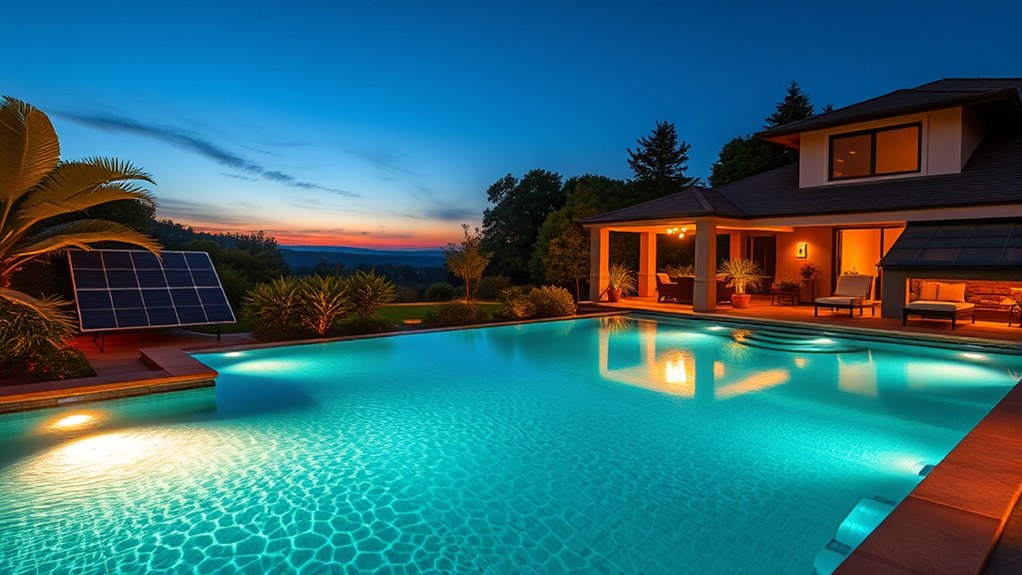
Several factors can markedly boost the energy consumption of your infinity pool. First, maintaining high water temperatures requires constant heater use, which consumes a lot of power. If you set your thermostat too high, you’ll spend more energy keeping the water warm. Second, continuous or inefficient circulation systems, like outdated pumps, can waste energy, especially if they run longer than necessary. Additionally, neglecting regular pool maintenance, such as cleaning filters, causes equipment to work harder and use more power. Using outdated or undersized equipment also pushes your energy bills higher. Furthermore, external factors like frequent rainfall or debris can lead to longer pump runs and increased energy use. Awareness of these factors helps you identify areas to improve efficiency and reduce your pool’s energy costs.
How Pool Size and Design Impact Power Usage
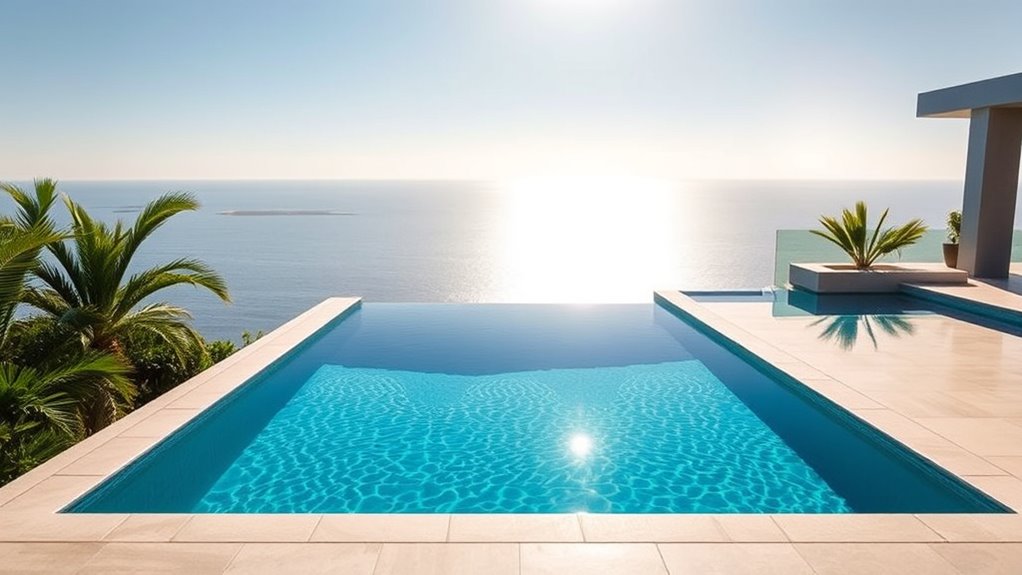
The size and design of your pool directly influence how much energy it consumes. A larger pool requires more water to heat, increasing energy use for temperature maintenance. Its shape also matters; irregular or complex designs often need more extensive lighting and circulation systems, which consume additional power. Deep pools demand more heating and filtration, raising energy costs. Conversely, a compact, simple design minimizes surface area, reducing heat loss and lowering heating needs. Features like waterfalls or elaborate lighting can add to power consumption, so choosing a streamlined design helps keep energy use in check. Additionally, efficient pool design can significantly reduce energy requirements by optimizing circulation and insulation. By selecting a practical size and straightforward shape, you can considerably cut your pool’s energy demands and your overall power bill.
The Role of Pumps and Filtration Systems
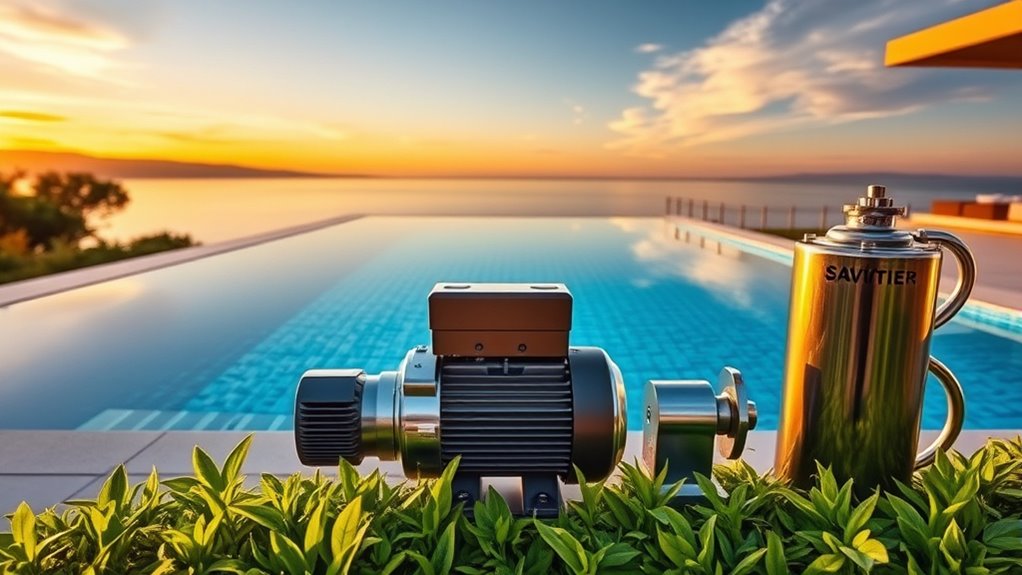
Pumps and filtration systems are vital components that directly affect your pool’s energy consumption. The pump circulates water through the filter, keeping your pool clean and safe. If your pump runs longer than necessary or is too powerful, it wastes energy. Modern pumps are designed with energy efficiency in mind, using variable speeds to match filtration needs. Proper sizing is essential; a pump that’s too large uses more power without added benefit. Regular maintenance, like cleaning filters and checking for leaks, ensures peak performance and reduces unnecessary energy use. Setting your pump to run during off-peak hours can also lower costs. Additionally, selecting energy-efficient pumps can significantly reduce your overall energy consumption. By understanding and managing your pump and filtration system, you can markedly reduce your pool’s energy consumption and save on your power bill.
Benefits of Energy-Efficient Equipment
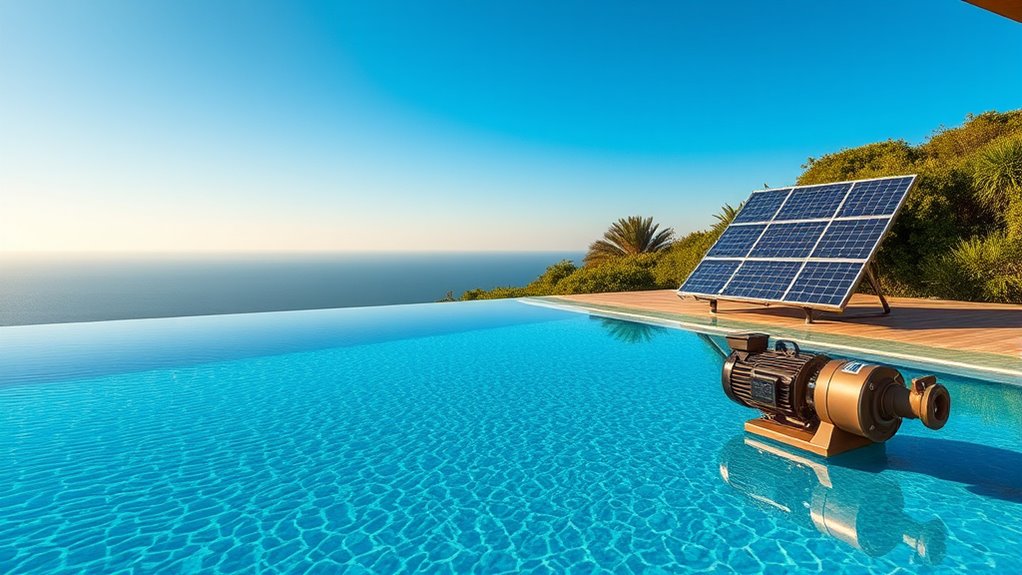
Switching to energy-efficient equipment can substantially lower your pool’s operating costs while maintaining ideal performance. These systems use advanced technology to consume less power without sacrificing effectiveness. For example, energy-efficient pumps work faster and more quietly, reducing electricity bills and noise. LED pool lighting uses a fraction of the energy of traditional bulbs, extending lifespan and lowering replacement costs. Modern heaters and filters are designed to optimize energy use, meaning you get warm water and clean water with less energy. Additionally, choosing energy-efficient equipment can improve your pool’s overall sustainability and reduce your carbon footprint. Investing in these upgrades not only saves you money month-to-month but also reduces your environmental impact. Over time, the savings on your power bill can offset the initial investment, making energy-efficient equipment a smart choice for any infinity pool owner.
Tips for Proper Pool Maintenance to Save Energy

Keeping your pool well-maintained can ensure energy costs are minimized. You should regularly clean your filter, schedule your pump to run efficiently, and cover your pool when it’s not in use. These simple steps help ensure your pool stays clean while saving you money on energy. Additionally, using timing controls can optimize pump operation for better energy efficiency.
Regular Filter Cleaning
Regular filter cleaning is essential for maintaining your pool’s energy efficiency. When filters clog with dirt and debris, your pump works harder to circulate water, increasing energy consumption. By cleaning your filter regularly, you ensure smooth water flow and reduce strain on the pump. Check your filter manufacturer’s instructions for cleaning frequency, typically every few weeks during heavy use. Rinse the filter thoroughly with a garden hose to remove dirt and debris, and replace any damaged components. A clean filter improves water clarity and reduces the workload on your pump, saving you energy and extending the lifespan of your equipment. Proper filtration is also influenced by color accuracy in projector technology, which impacts overall image quality. Consistent maintenance keeps your pool running efficiently and helps cut down on your monthly power bills.
Optimal Pump Scheduling
Proper pump scheduling can considerably cut your pool’s energy costs. Instead of running the pump constantly, set it to operate during peak filtration hours—early morning or late evening. This ensures your pool stays clean without wasting energy when it’s not needed. To optimize your schedule, consider these tips:
- Run the pump for shorter, more frequent intervals rather than long, continuous sessions
- Adjust the timing based on pool usage and weather conditions
- Use a timer to automate the process for consistent operation
- Additionally, understanding the energy-efficient features of your pool equipment can help you select the best options for reducing power consumption
Cover Your Pool
Covering your pool when it’s not in use can considerably reduce heat loss and evaporation, which in turn lowers your energy costs. A pool cover acts as an insulating barrier, keeping warm water in and cold air out, especially during cooler nights. It also minimizes evaporation, helping you retain water and heat without overworking your heater. Properly covering your pool daily saves energy by decreasing the workload on your heating system and maintaining consistent water temperature. Make sure to choose a cover that fits snugly and is durable enough for your climate. Regularly cleaning and inspecting your cover prevents debris buildup and ensures maximum efficiency. Additionally, selecting the right pool cover material can further enhance insulation and durability. By covering your pool consistently, you’ll cut down on energy consumption and extend the lifespan of your heating equipment.
Incorporating Solar Power and Other Renewable Options
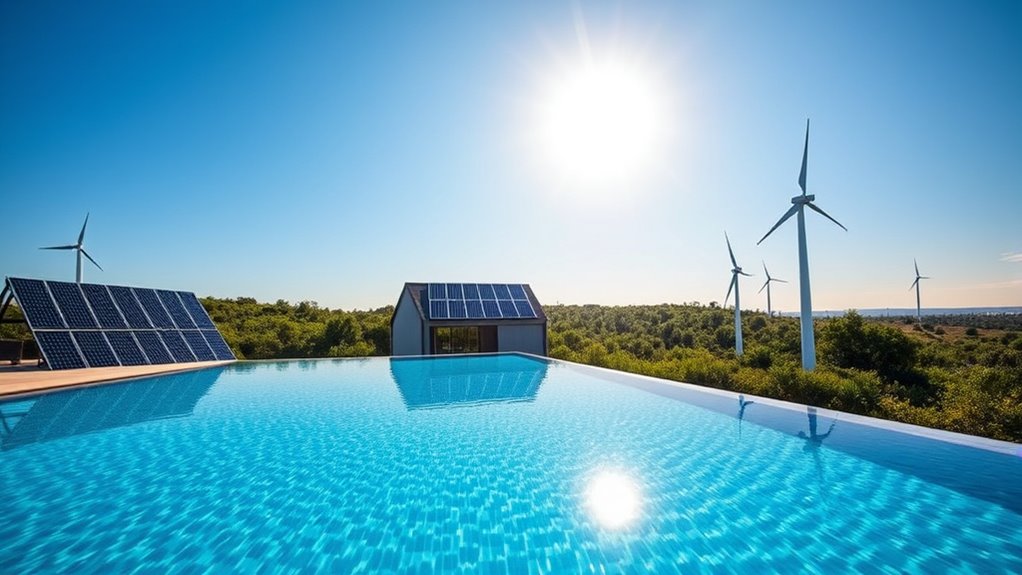
Incorporating solar power and other renewable options can considerably cut your energy costs. Installing solar panels requires careful planning and understanding of the best placement and system size. Exploring alternative sources and cost-saving strategies helps maximize your investment and reduce your utility bills. Additionally, understanding energy consumption trends can guide you in optimizing your overall energy use for greater savings.
Solar Panel Installation Tips
To maximize your energy savings, start by evaluating your home’s sunlight exposure and shading patterns. This helps determine the best placement for your solar panels, ensuring they receive maximum sunlight throughout the day. When installing, keep these tips in mind:
- Position panels at an ideal angle, usually equal to your latitude, for peak efficiency.
- Avoid shading from trees, chimneys, or neighboring structures during peak sunlight hours.
- Regularly clean panels to prevent dust and debris buildup that can reduce output.
- Consider empowering families in caregiving journeys by seeking professional advice or assistance to optimize your solar setup and maintenance.
Additionally, consider mounting panels on a sturdy, unobstructed roof or a ground setup with clear southern exposure. Proper placement and maintenance are key to getting the most out of your solar investment and cutting your energy bills dramatically.
Alternative Renewable Sources
By combining solar power with other renewable energy options, you can substantially reduce your reliance on traditional electricity sources and lower your utility bills. Wind turbines, small-scale hydro systems, and biomass can complement solar panels, especially when sunlight isn’t consistent. These alternatives harness natural resources, providing clean energy around the clock. Installing a hybrid system ensures a more stable energy supply and maximizes your renewable investments. Many regions offer incentives for incorporating multiple renewable sources, making it more affordable to diversify your setup. Before choosing, evaluate your location’s natural resources and energy needs. By leveraging a mix of renewables, you not only cut costs but also contribute to a healthier environment and reduce your carbon footprint. Incorporating emotional support strategies can help manage the stress of transitioning to renewable energy, ensuring a smoother adoption process. It’s a smart way to power your infinity pool sustainably.
Cost Savings Strategies
Combining multiple renewable energy sources not only boosts your environmental impact but also substantially cuts your long-term energy costs. By integrating solar panels, wind turbines, or small hydro systems, you diversify your energy supply and reduce reliance on the grid. This approach maximizes savings and increases energy independence. To make the most of these strategies, consider:
- Installing solar panels to generate daytime power and offset high-energy periods
- Using energy-efficient appliances to reduce overall consumption
- Incorporating smart energy management systems for real-time monitoring and optimization
These actions help lower your bills while supporting sustainable practices. The key is to pair renewable options with efficiency measures, ensuring you get the highest return on investment and keep your infinity pool’s energy use in check.
Smart Technologies to Monitor and Control Energy Use
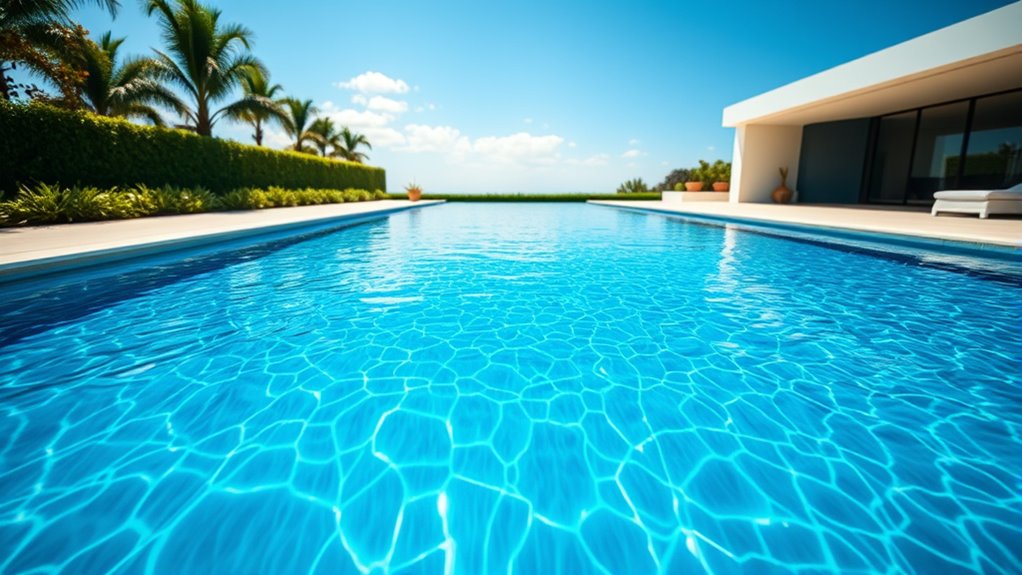
Smart technologies have revolutionized how you monitor and control energy use, making it easier to reduce costs and improve efficiency. With smart meters and connected devices, you get real-time data on your energy consumption, so you can identify patterns and pinpoint areas for savings. Smart thermostats let you adjust pool heating schedules remotely, ensuring you only use energy when needed. Automated control systems can optimize pump and filter operation based on usage, preventing waste. Mobile apps provide instant insights and control at your fingertips, allowing you to make adjustments on the go. By integrating these technologies, you gain greater visibility and command over your energy use, helping you cut costs while maintaining your infinity pool’s comfort and functionality.
Budget-Friendly Strategies to Reduce Your Pool’s Energy Costs
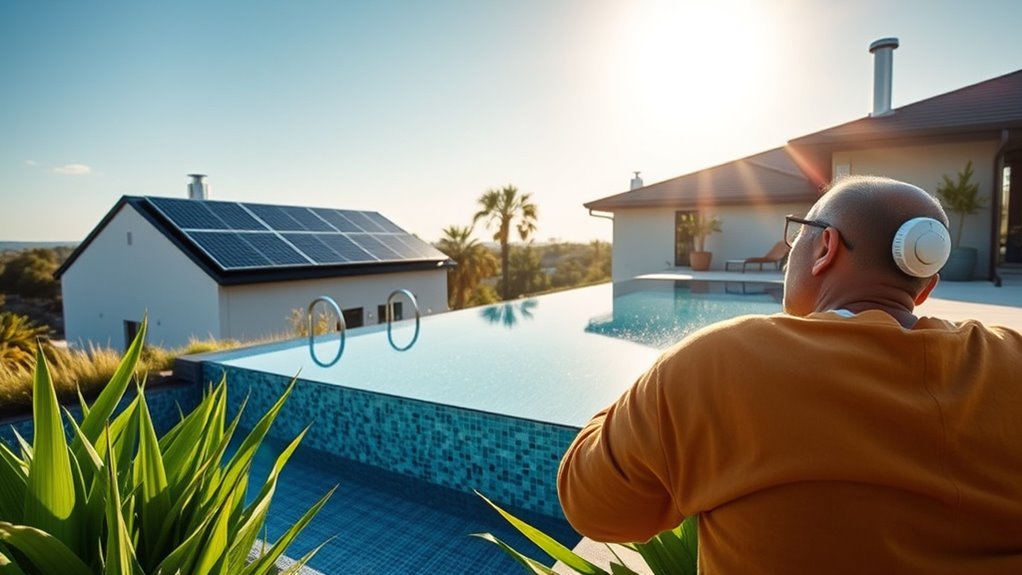
Implementing budget-friendly strategies can considerably lower your pool’s energy costs without sacrificing comfort. Start by maintaining ideal water temperature—setting your heater a few degrees lower can save significant energy. Regularly cleaning filters ensures efficient operation, reducing unnecessary energy use. Additionally, consider the following cost-effective tips:
- Use a pool cover to retain heat and minimize evaporation
- Schedule pump operation during off-peak hours
- Install a timer to control pump and heater usage precisely
These simple steps help cut down energy consumption without major upgrades or expenses. By making small adjustments and leveraging existing equipment more efficiently, you can enjoy your infinity pool while keeping your energy bills in check. The key is to be intentional and consistent with your energy-saving practices.
Frequently Asked Questions
How Does Outdoor Climate Affect Infinity Pool Energy Consumption?
Outdoor climate greatly impacts your infinity pool’s energy consumption. In hot weather, you’ll use less energy because the water stays warm naturally, reducing heater use. Conversely, in cooler or windy conditions, you’ll need more energy to keep the water comfortable, especially if temperatures drop markedly. Extreme weather, like storms, can also increase energy needs due to evaporation and the need for additional filtration or heating to maintain water quality.
Can Insulation Reduce Energy Costs for Infinity Pools?
Yes, insulation can reduce your infinity pool’s energy costs. It helps retain heat, so your heater doesn’t work as hard to maintain the desired temperature. Proper insulation around the pool’s edges, cover, and plumbing minimizes heat loss caused by outdoor temperatures and wind. This means you’ll use less energy, save money, and enjoy a warmer pool longer without increasing your bills. Insulation is a smart investment for energy efficiency.
Are There Government Incentives for Energy-Efficient Pool Equipment?
Yes, there are government incentives for energy-efficient pool equipment. You can often find rebates, tax credits, or grants that help offset the costs of upgrading to energy-saving pumps, heaters, or lighting. To take advantage of these, check with your local or federal programs, and guarantee your equipment meets the efficiency standards required. Doing so not only saves energy but also reduces your long-term expenses.
How Often Should Pool Equipment Be Serviced to Optimize Energy Use?
You should service your pool equipment at least once a year to keep it running efficiently. However, if you notice signs of wear or unusual noise, consider servicing it more often, around every 6 months. Regular maintenance includes cleaning filters, checking for leaks, and inspecting motors, which helps prevent energy waste. Staying proactive guarantees your pool uses less energy and saves you money on your bills.
What Are the Long-Term Cost Benefits of Upgrading to Renewable Energy?
Upgrading to renewable energy saves you money long-term by reducing or eliminating your electricity bills and protecting you from energy price hikes. You’ll also benefit from government incentives and tax credits that lower initial costs. Over time, these savings add up, making your investment more affordable. Plus, using cleaner energy helps the environment, giving you a sense of doing your part for a sustainable future while cutting costs.
Conclusion
Think of your infinity pool like a high-performance car — with the right tweaks, you can keep it running smoothly without breaking the bank. By understanding energy demands and embracing smart, efficient solutions, you might even find that solar power or simple maintenance tricks can slash your bills. Some say energy-efficient equipment doesn’t make much difference, but evidence shows it can save you hundreds annually. So, take control, and enjoy your luxurious pool without the hefty price tag.

